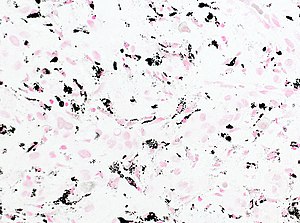Fontana-Masson stain
Jump to navigation
Jump to search
The printable version is no longer supported and may have rendering errors. Please update your browser bookmarks and please use the default browser print function instead.
Fontana-Masson stain is a special stain that marks the pigment melanin. It is a type of silver stain.[citation needed]
It is also known as Masson-Fontana stain,[1] Fontana-Masson stain for melanin, and melanin stain.
Stains
- Melanin.
- "Argentaffin granules" of the digestive tract.
- Pigment deposition due to minocycline treatment.[2]
Use
- Stain for melanin.
- Displays melanin - whether it be in melanocytes, keratinocytes or melanophages.
- IHC stains, i.e. Melan A, SOX10 or MITF are preferable for displaying melanocytes.
- Used to differentiate brown pigments (lipofuscin, hemosiderin, melanin).[3]
- Used to document Minocycline type II drug induced pigment deposition
- Minocycline pigment, Type II will stain with both the Fontana-Masson stain AND the Perls iron stain.[4]
- Used in the differential diagnosis of hypomelanosis
- Idiopathic hypomelanosis will demonstrate ONLY loss of melanin with the Fontana-Masson stain - melanocytes will not be absent with the Melan A stain.
- Vitiligo will show loss of melanin AND loss of melanocytes with a Melan A stain.
See also
References
- ↑ Gaitanis, G.; Chasapi, V.; Velegraki, A. (Aug 2005). "Novel application of the masson-fontana stain for demonstrating Malassezia species melanin-like pigment production in vitro and in clinical specimens.". J Clin Microbiol 43 (8): 4147-51. doi:10.1128/JCM.43.8.4147-4151.2005. PMID 16081962.
- ↑ Patterson, JW.; Wilson, B.; Wick, MR.; Heath, C. (Nov 2004). "Hyperpigmented scar due to minocycline therapy.". Cutis 74 (5): 293-8. PMID 15605966.
- ↑ URL: http://education.vetmed.vt.edu/curriculum/VM8054/labs/Lab2/Examples/exfontana.htm. Accessed on: 5 May 2010.
- ↑ Geria AN, Tajirian AL, Kihiczak G, Schwartz RA (2009). "Minocycline-induced skin pigmentation: an update". Acta Dermatovenerol Croat 17 (2): 123–6. PMID 19595269.
